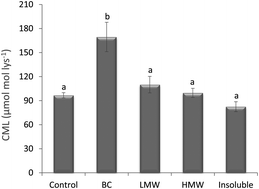Metabolic transit of Nε-carboxymethyl-lysine after consumption of AGEs from bread crust
Abstract
Our aim was to investigate

- This article is part of the themed collection: The Maillard reaction in food and nutrition
* Corresponding authors
a
Instituto en Formación de Nutrición Animal, Estación Experimental del Zaidín, CSIC, Camino del Jueves s/n, 18100, Armilla, Granada, Spain
E-mail:
cdelgado@eez.csic.es
Fax: +34 958 572753
Tel: +34 958 572757
b Institut Polytechnique LaSalle Beauvais, Beauvais, France
c Case Western Research University, Cleveland, Ohio, USA
Our aim was to investigate

 Please wait while we load your content...
Something went wrong. Try again?
Please wait while we load your content...
Something went wrong. Try again?
I. Roncero-Ramos, C. Delgado-Andrade, F. J. Tessier, C. Niquet-Léridon, C. Strauch, V. M. Monnier and M. P. Navarro, Food Funct., 2013, 4, 1032 DOI: 10.1039/C3FO30351A
To request permission to reproduce material from this article, please go to the Copyright Clearance Center request page.
If you are an author contributing to an RSC publication, you do not need to request permission provided correct acknowledgement is given.
If you are the author of this article, you do not need to request permission to reproduce figures and diagrams provided correct acknowledgement is given. If you want to reproduce the whole article in a third-party publication (excluding your thesis/dissertation for which permission is not required) please go to the Copyright Clearance Center request page.
Read more about how to correctly acknowledge RSC content.
 Fetching data from CrossRef.
Fetching data from CrossRef.
This may take some time to load.
Loading related content
